|
Location:
Boyne Valley, Nr Slane,
County Meath. |
Grid Reference:
53�
41' 39.73" N. 6� 28' 30.11" W. |
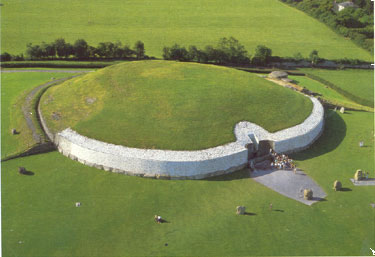
 Newgrange:
(Passage Mound).
Newgrange:
(Passage Mound).
The Newgrange passage-mound sits at the heart of the Boyne valley complex.
The structure is composed of 280,000 tons of river rolled stones, and the
white granite that makes up the exterior face was transported especially
from the coast, 50 miles away.
Although Newgrange has been modernised 'through
the eyes of a seventies design junkie', the atmosphere of the site still
opens the prehistoric eye.
(Schematic of interior of Newgrange)
(Overhead plan
of Newgrange)
Surrounded by a stone
circle (12 remaining from an estimated original 36), with 97 Kerb-stones,
an internal cruciform chamber and corbelled roof, the grandiose
scale of the earth-works at Newgrange make it one of the most
spectacular of prehistoric monuments in all Europe. The recognition that
it provides an accurate means of measuring the solar year (to
within a margin of several minutes),
is testimony to the prehistoric mind.
Newgrange
is currently in the care of
Heritage Ireland
, and access is by guided tour only.
According to Irish mythology Newgrange was one of the
sidhe, or fairy-mounds, where the Tuatha De Danann lived. It was built
by the god Dagda, but his son Oengus later tricked him out of it. It is
named for the goddess Boann, the mother of Aengus, who is also credited
with the creation of the River Boyne.
Newgrange has been radio-carbon dated to
around 3,200 BC (2)
'originally
built between c. 3300 and 2900 BC'
- Ref: (wikipedia).
Construction Features:
There are numerous
construction features within the design of this passage mound that stand
out in their technical expertise. In fact, what we see at Newgrange, is
the Neolithic response to a desire to measure the solar year exactly,
and that is exactly what they achieved. Each individual design feature
in and around the passage-mound is the result of the imagination
overcoming this awesome task. We are offered at Newgrange, a chance to
step into the mind of the megalithic builders.
The primary construction features at Newgrange combine to create the effect
that a small dagger of sunlight travels along the passage floor into the
central chamber for exactly 17 minutes each year.
The site was first investigated by
antiquarians in the 17th century and there have been several
studies and excavations since then.
The current shape of the mound
-
There was much controversy
over the reconstruction of the structure, especially the white quartz
wall on top of the South-East sector of the kerb, which was based on the
position of the white quartz layers found during excavations between
1962 and 1975. The eventual reconstruction is an
interpretation
of remains from a totally collapsed site. The shape of the front is also
not authentic, but was deliberately
left indented to emphasise the entrance. The darker square-stones in the
wall surrounding the entrance are also
not
authentic. Similarly, the kerb-stones have been placed into the mound,
and under a concrete sill 'to protect them'. It is these changes which
have given the structure the 'modern' feel it has today.
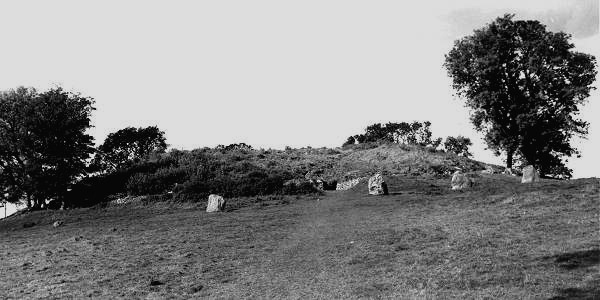
Newgrange before
any restoration at the turn of the century.
The mound is not a perfect
circle, but is made up of a series of sections of parabolas, supporting
Prof. A. Thom's assertion of geometry in the design.
Around the mound are 12 standing
stones which are believed to have been set up the same time. The
kerb-stone that lies before the passage has carvings similar to one
found on the Orkneys,
and another found at
Bugibba, Malta.
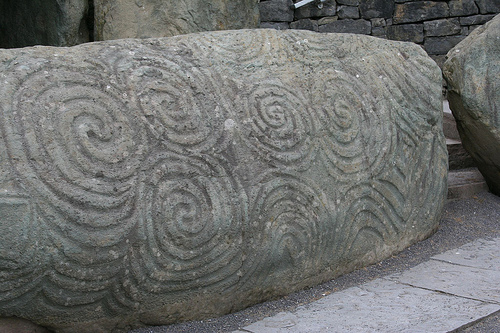
The beautifully carved Kerb-stone in
front of the entrance to the passage-mound.
(Note: The spirals rotate clockwise
on the left hand side of the stone, and anti-clockwise on the right).
The Kerb-stones - All the
mounds in the Boyne valley have kerb-stones, The Newgrange mound is surrounded by
97 granite 'Kerb-stones', with carvings only visible on a few. It has
been pointed out that the stones with the most carvings on are also the
most significantly astronomically aligned, leading to suggestions that
the carvings have an astronomically significance themselves.
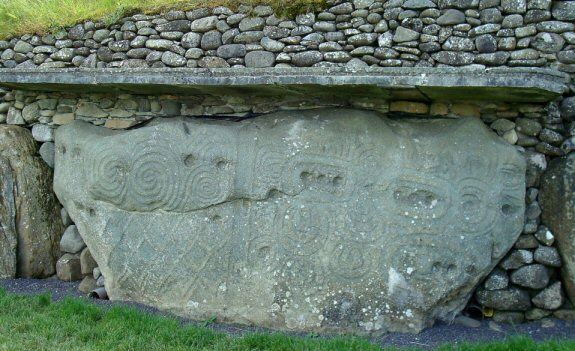
The rear
kerb-stone (K52). A line divides the art into two halves.
(Click
here for individual images of each kerbstone)
The Entrance:
The following
pictures illustrate the changes that have been made since restoration.
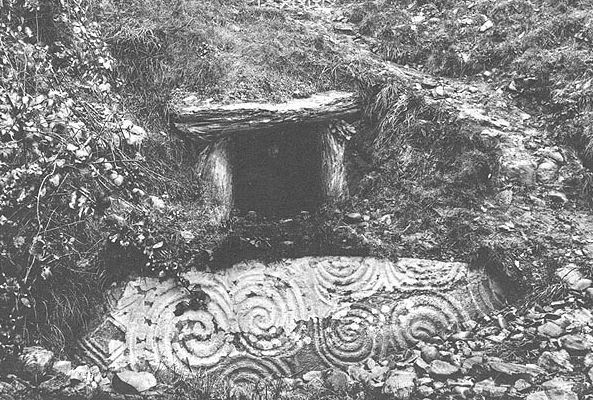
The entrance as it was at the turn of the century.
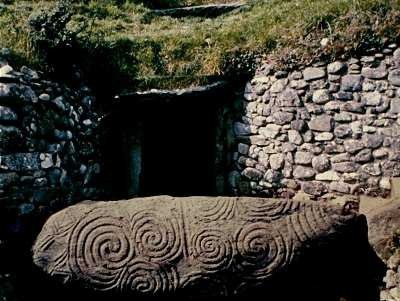
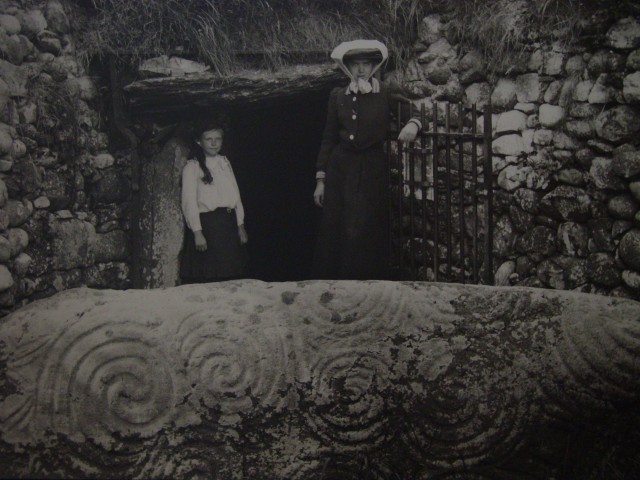
The entrance after first restoration, but still
before the Disneyfication of the 1970's.
The
Light-box/Roof-box -
Above the
entrance passage is a 'light-box', which precisely aligns with the
rising sun at the winter solstice of 21st December, so that the rays
touch the ground at the very centre of the tomb for about 20 minutes.
Many of the upright stones along the walls of the 19m (62ft) passage,
which follows the rise of the hill, are richly decorated.
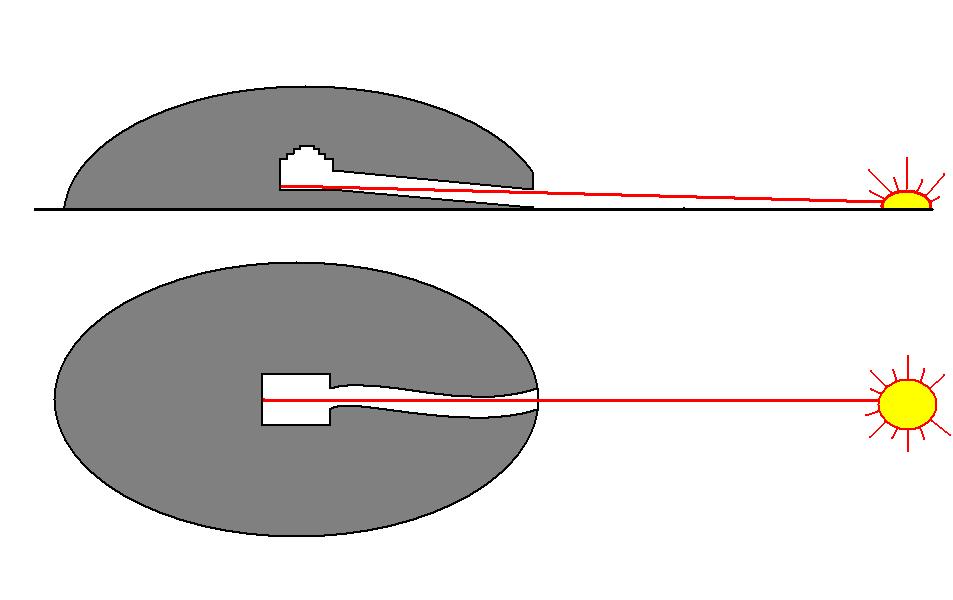
The light-box
combines with other design features so that the light is narrowed with
the result that a small 'dagger' of light slides along the floor of the
passage towards the inner chamber, where it illuminates it for 17
minutes a year.
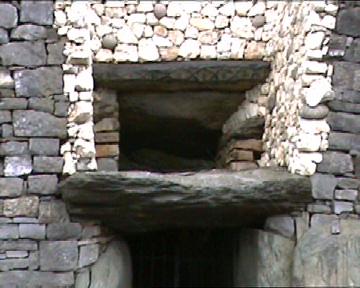 There are suggestions of roof-boxes
at other UK sites. There is another at
Carrowkeel in Ireland, and similar light
effects are recorded at Bryn-celli-Ddu in Wales There are suggestions of roof-boxes
at other UK sites. There is another at
Carrowkeel in Ireland, and similar light
effects are recorded at Bryn-celli-Ddu in Wales
(To be confirmed), and
Maes-Howe on the Orkneys.
Similar carvings as those found on
the front face of the lintel of the roof box can be seen at other
passage mounds, such as at
Fourknocks and
Gavr'inis, (both orientated astronomically), which has led some to suggest that this
design might have had a significance (rather
than just abstract art).
The stone at Newgrange appears to
have eight crosses on its face, but a diagram of the stone before
reconstruction (below), suggests that there may have once been another cross on
the face, which would make a total of nine crosses, the same as at
Gavr'inis..
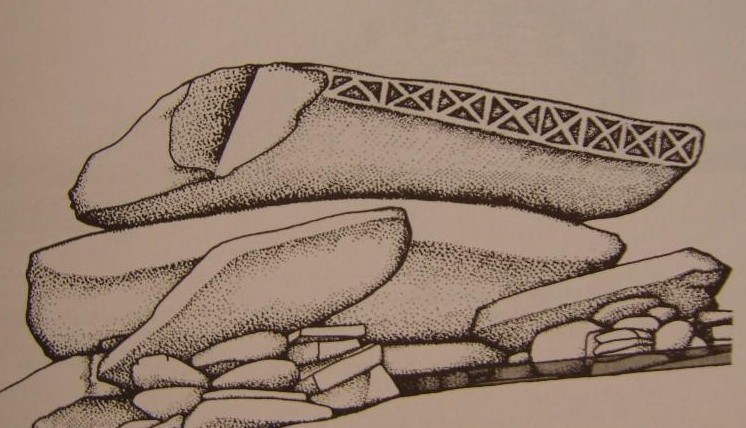 |

The stone
above can be seen in the east recess of the cruciform
chamber inside Newgrange. It is very similar in style to art seen on
lintel-stones at Fourknocks.
|
(More
about light-boxes)
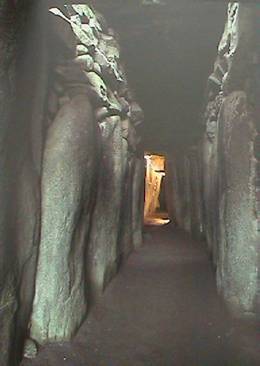 Inside the Mound:
The
passage slopes upwards towards the centre of the tomb so that the
floor-level inside the chamber is at the same height as the ceiling
level at the entrance, the passage also undulates from side to side
along its length. The combined effect of these two features is that the
light that enters the passage is narrowed both vertically and
horizontally into a small focused beam of light that only penetrates the
internal chamber for a few minutes on the winter solstice.
The stones that cover the passage had
small channels cut into them on their upper-faces to keep the passage dry. Similarly, the
stones that compose the corbelled roof of the chamber are all sloped
downwards on the outside, also presumable to keep the chamber dry. These
features highlight the skill of the builders, and lend weight to the
idea that the
structure was built for long-term use (rather than as a funerary
structure).
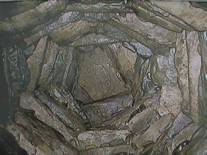 Inside
the heart of the mound is a single corbelled chamber entered through the
passage orientated towards the sunrise on the winter solstice. The internal
plan is in the form of a cross (cruciform), and is lined with large slabs of rock.
The cruciform chamber inside the mound measures 6.5 x 6.2m (21ft 6in x
17ft), has three recesses, and is topped by a magnificent corbelled roof
reaching to a height of 6m (20ft) above the floor. In the recesses are
three massive stone basins (similar to those found in the temples on
Malta), and which presumably served some ritual use.
The basin in the back
alcove was broken a few hundred years ago by a treasure hunter.
(16).
Excavations in the central chamber
produced the remains of two burials and at least three cremated bodies
as well as seven marbles, four pendants, two beads, a flint flake, a
bone chisel, and fragments of several bone pins and points. Inside
the heart of the mound is a single corbelled chamber entered through the
passage orientated towards the sunrise on the winter solstice. The internal
plan is in the form of a cross (cruciform), and is lined with large slabs of rock.
The cruciform chamber inside the mound measures 6.5 x 6.2m (21ft 6in x
17ft), has three recesses, and is topped by a magnificent corbelled roof
reaching to a height of 6m (20ft) above the floor. In the recesses are
three massive stone basins (similar to those found in the temples on
Malta), and which presumably served some ritual use.
The basin in the back
alcove was broken a few hundred years ago by a treasure hunter.
(16).
Excavations in the central chamber
produced the remains of two burials and at least three cremated bodies
as well as seven marbles, four pendants, two beads, a flint flake, a
bone chisel, and fragments of several bone pins and points.
Cruciform passage graves
describe a complex example of prehistoric passage mound found in
Ireland,
Wales and the Orkneys
and built during the later Neolithic, 'from around 3,500 BC and
later'
(1).
The cruciform shape of the interior
chambers is a common prehistoric design feature, seen in several
prehistoric structures from different European sites in Scotland, France
and Malta. It is interesting that in several of these locations, large
round 'offering bowls' have been found. (Such as
Maes Howe, Orkneys and the
Tarxien, Malta).
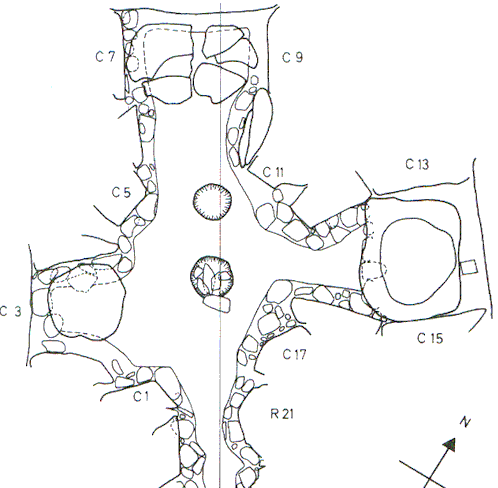 They are distinguished by a long
passage leading to a central chamber with a corbelled roof. From this,
burial chambers extend in three directions, giving the overall
impression in plan of a cross shape layout. Some examples have further
sub-chambers leading off the three original chambers. The network of
chambers is covered by a cairn and lined outside with kerb-stones. They are distinguished by a long
passage leading to a central chamber with a corbelled roof. From this,
burial chambers extend in three directions, giving the overall
impression in plan of a cross shape layout. Some examples have further
sub-chambers leading off the three original chambers. The network of
chambers is covered by a cairn and lined outside with kerb-stones.
A common trait is megalithic art
carved into the stones of the chambers' walls and roofs. Abstract
designs were favoured, especially spirals and zig-zags.
Examples are
Newgrange ,
Knowth,
Dowth and Fourknocks
(amongst many) in Ireland,
Maes howe in
Orkney, 'La Hougue Bie' on Jersey and Barclodiad-y-Gawres in Anglesey.
(Cruciform chambers and 'libation bowls')
Chronology -
Newgrange has been radio-carbon dated to
around 3,200 BC:
'originally
built between c. 3300 and 2900 BC'
- Ref: (wikipedia).
It gets its modern name from the
fact that by 1142, the site had become part of Mellifont Abbey farm.
These farms were known as granges, and by 14th century the site was
known only as the 'New Grange'. In early Irish mythology, Newgrange was
not only the alleged burial place of the prehistoric kings of
Tara, but also the home of a race of Irish supernatural beings,
known as 'Tuatha de Danann' : the people of the goddess Danu. Newgrange
was also taken to be the house of the patriarchal god Dagda.
Archaeo-astronomy
-
(Arguably the whole point of the structure).
The most noticeable astronomical
feature of Newgrange is the orientation of the passage towards the
winter solstice sunrise. Although, in itself this no mean feat of
engineering. What is amazing is that the designers managed to narrow the
beam of solstice sunlight into such a small beam of light, and then have
it travelling upward along the channel towards the chamber. In addition, the light-box itself
has been designed so as to enhance this effect. Newgrange is just one
part of a huge observatory that is the 'Boyne valley complex'.
Newgrange is
noticeably orientated towards Fourknocks,
several kilometres away.
(More about Light-boxes)
(Archaeoastronomy
Homepage)
Examples of
spiral-'art' at Newgrange -
There are several spirals
at Newgrange, both inside the structure and out. There meaning is still
only guessed at, but it has been suggested that they relate to the solar
cycle. It is noticeable that the spirals on the kerb-stone directly in
front of the passage appear to rotate clockwise on the left side and
anticlockwise on the right.
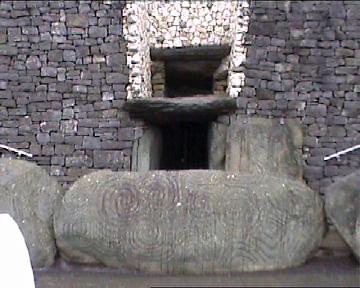
Information has emerged in
favour of the suggestion that they have an astronomical meaning. An
American artist has apparently shown though experiment, how the suns
rays, when projected onto an object and recorded at the same time each
day over a full year, create the shape of a double-spiral
(What then is the meaning
of the triple spiral?).
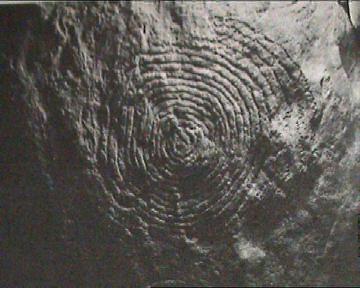 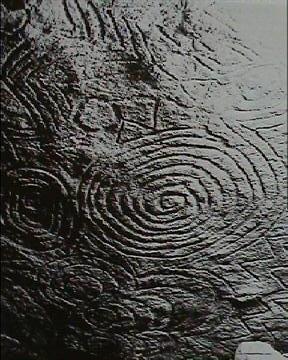
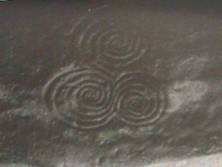
There are several
sets of double and triple spirals in the chambers and passage of the
mound.
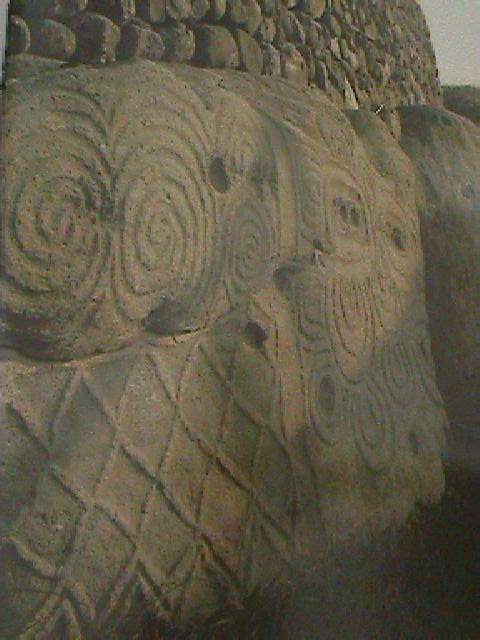
The
Spiral-art on the stone
diametrically opposite the entrance kerbstone. The art is reminiscent of
rock-art found at
Maes Howe in the Orkneys,
Malta (Bugibba
in particular), and
Gavr'inis in France.
(Spirals
Homepage)
(The
Boyne Valley Complex)
(Knowth)
(Dowth)
(Passage
Mounds)
(Archaeoastronomy)
(Other
Prehistoric Irish Sites)
|







 There are suggestions of roof-boxes
at other UK sites. There is another at
There are suggestions of roof-boxes
at other UK sites. There is another at 

 Inside
the heart of the mound is a single corbelled chamber entered through the
passage orientated towards the sunrise on the winter solstice. The internal
plan is in the form of a cross (cruciform), and is lined with large slabs of rock.
Inside
the heart of the mound is a single corbelled chamber entered through the
passage orientated towards the sunrise on the winter solstice. The internal
plan is in the form of a cross (cruciform), and is lined with large slabs of rock. They are distinguished by a long
passage leading to a central chamber with a corbelled roof. From this,
burial chambers extend in three directions, giving the overall
impression in plan of a cross shape layout. Some examples have further
sub-chambers leading off the three original chambers. The network of
chambers is covered by a cairn and lined outside with kerb-stones.
They are distinguished by a long
passage leading to a central chamber with a corbelled roof. From this,
burial chambers extend in three directions, giving the overall
impression in plan of a cross shape layout. Some examples have further
sub-chambers leading off the three original chambers. The network of
chambers is covered by a cairn and lined outside with kerb-stones.



